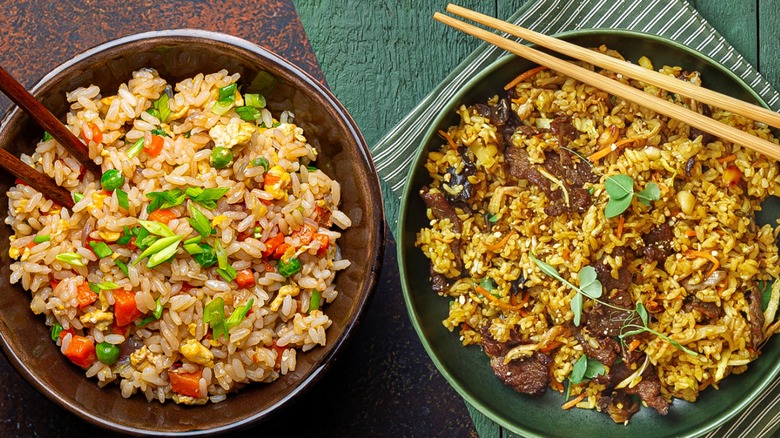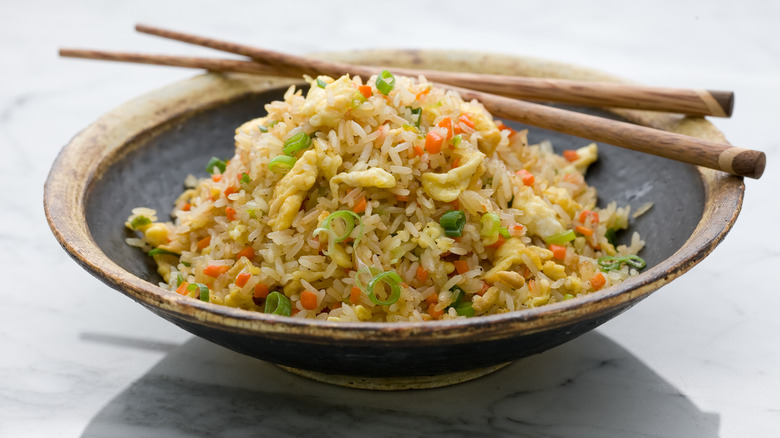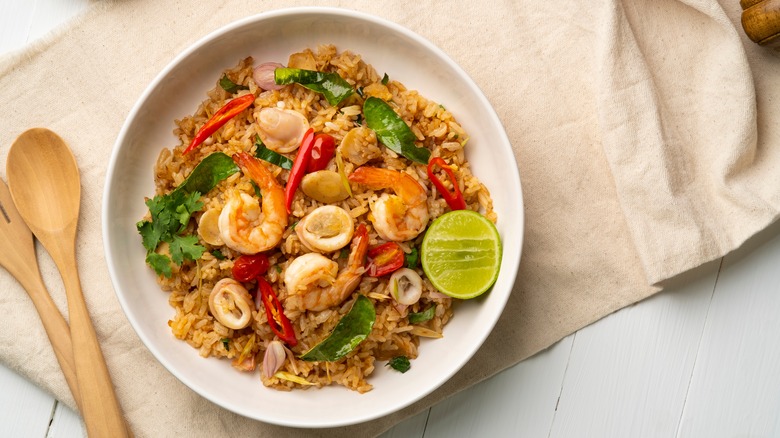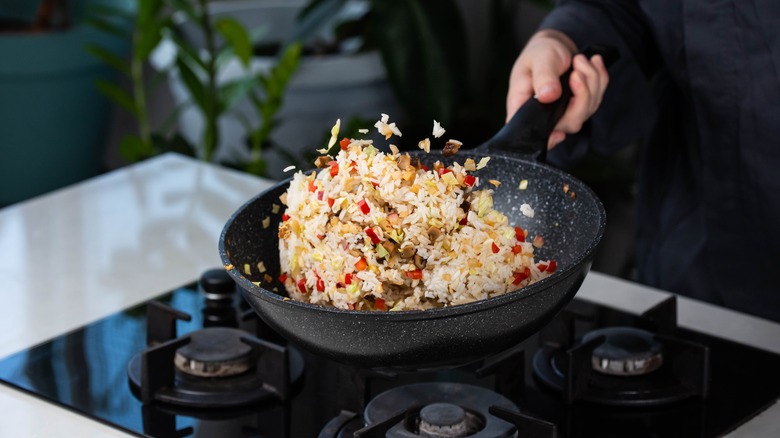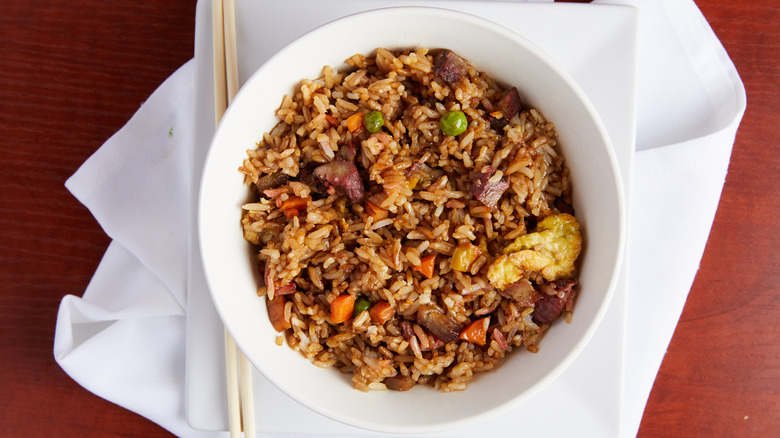Chinese Vs Thai Fried Rice: What's The Difference?
We dare foodies to name a more versatile comfort food than fried rice. When epicures are yearning for a taste of something warming, nourishing, and easy on the stomach, chances are, they're picking up the phone or taking a walk down the block to secure the bag (it's also wicked easy to whip up a killer batch of fried rice at home, for the record). Maybe folks are headed toward the plexiglass window of their go-to local Chinese restaurant, beaming softly like an everyman's "Nighthawks." Or maybe they're headed to their local Thai joint and unfolding a paper takeout menu. For foodies hungry for a taste of the truth, what's the actual difference between Chinese and Thai-style fried rice?
The foundational formula for any fried rice is (surprise) rice stir-fried with protein, vegetables, and a light sauce to combine. So it doesn't especially help the task of distinguishing Chinese from Thai fried rice that they both use many of the same ingredients. One of the most obviously observable differences is their plating: Thai fried rice is plated with lime, sliced cucumber, and sometimes wedges of tomato, while Chinese fried rice is typically served on its own sans-garnish. But the differences between these dishes extends further than skin-deep. The main difference is that Thai fried rice is fried to a smoky, charred crisp and loaded with bold, fragrant, zesty, spicy flavors, while Chinese fried rice is light, fluffy, and understatedly mild in taste.
What is Chinese fried rice?
Chinese fried rice is all about simplicity and balance. It's made from long-grain rice, which can be jasmine, basmati, or long-grain Indica rice. Chinese fried rice should have a fluffy, light texture. Two or three day-old fried rice works best for fluffing. This is what is commonly used in restaurants and why Chinese-style fried rice is so commonly turned to as a thrifty way to use up leftover rice the next day.
Chinese fried rice is typically loaded with diced carrots, peas, corn, and protein like fluffy scrambled eggs and pork belly. Shrimp, chicken, Spam, and tofu are also popular, as is char siu barbecued pork. Other common fixtures include mung bean sprouts, garlic, ginger, and green onion. The sauce in Chinese fried rice is a light combination of soy sauce, sesame oil, and Shaoxing rice wine, making for an understated and balanced flavor profile. Foodies in China have been enjoying some version of fried rice since at least the Sui Dynasty (589-618 C.E.). Today, regional varieties have emerged, most commonly Yangzhou, Fujian hokkien, and spicy Sichuan fried rice, with Yangzhou being the most widely-enjoyed version worldwide.
What is Thai fried rice?
Thai fried rice is zesty and robust — a lively combination of the bold, aromatic flavors characteristic of the Thai culinary palate. It's made with fragrant jasmine rice, protein, and veggies, typically garlic, onion, Chinese broccoli, red bell peppers, Thai bird's eye chilies, chicken, head-on prawns, or tofu. The ingredients are all married in a lush blanket of fish sauce, oyster sauce, or a combination of both. One of the star ingredients in Thai fried rice is Thai basil, which features a distinct, sharp black licorice aroma and bite compared to sweet, earthy Italian basil. Thai basil also looks physically different from Italian basil, with dark purple stems and dark green pointed leaves.
In Thai fried rice, prik nam pla (a mixture of chilis and fish sauce) is both incorporated into the stir-fry pan as well as served alongside the plated dish as a flavorful garnish. In fact, a jar of prik nam pla is a common fixture on the table at most Thai restaurants. The result is a spicy, bold fried rice dish loaded with heat from the chilis, strong umami funk from the oyster sauce, and the dimensional herbaceousness of the Thai basil — this complex interplay is what makes Thai fried rice the totally unique amalgam that it is.
Thai fried rice gets charred over high heat
The chief difference between these two fried rice dishes lies in their preparation. Thai fried rice is typically cooked at high heat, imparting the smoky, slightly charred flavor for which the dish is known. This is why a carbon-steel wok is traditionally the best tool for assembling this dish and achieving wok hei, the name for the specific smoky charred flavor that woks can create thanks to their capacity for cooking over high heat.
Conversely, Chinese fried rice is meant to be soft and fluffy texturally, absent of Thai fried rice's smoky crisp. This is why Chinese fried rice is traditionally made using recooked rice, which is dryer than fresh rice and more readily absorbs flavors from other ingredients in the pan, like cooking oil and veggie juices. The dry texture of leftover rice also means that it isn't weighed down by any excess water, which would make the fried rice overly dense and cause it to clump together.
Chinese fried rice is understated and mild
Perhaps unsurprisingly, thanks to their dramatically different ingredients, Thai and Chinese fried rice offer wildly different tastes. The big distinguishers of Thai fried rice are the fish or oyster sauce, spicy chilis, and Thai basil. These bold players create a salty, garlicky, and spicy flavor compared to Chinese fried rice. It's worth noting that Chinese fried rice also commonly includes fish sauce, but if it's used, it appears as a more subtle background ingredient than as the pungent star that it is in Thai fried rice.
Garlic tends to be included in Thai fried rice but not always in the Chinese variety. Also, Chinese fried rice is always made with long-grain rice. It can be jasmine, basmati, or white, but the long-grain aspect is more important here than the specific type, unlike in Thai fried rice, where the jasmine flavor is crucial.
In contrast to Thai fried rice's zestiness, understated Chinese fried rice is more about a balanced cohesion of flavors. It's cooked for a longer time over a lower temperature, during which the tastes are married together in the pan into a uniform sum-of-its-parts taste. Minimal seasonings are added because, in Chinese fried rice, the most dominant flavors are meant to come from the union of the stir-fried ingredients.
